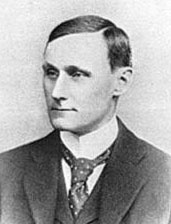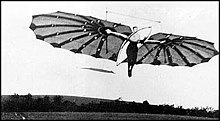Percy Pilcher
Percy Sinclair Pilcher (born January 16, 1866 in Bath - † October 2, 1899 in Stanford Hall , Harborough District , United Kingdom ) was a British inventor and aviation pioneer who could have made it before the Wright brothers , the first to complete motorized flight.
Life
Pilcher was the son of the former curator of the British Museum Thomas Webb Pilcher and his second wife Sophia Robinson. When her father died in 1874, the widow and her children settled with relatives in Celle (Germany). When the mother died there in 1877, the eldest brother Thomas Percy Pilcher went back to England with his siblings.
After a rather short school period, Pilcher volunteered as a cadet in the Royal Navy in 1880 . In 1887 he left the Navy to work in a shipyard in Glasgow .
In 1899, Pilcher built his glider called The Hawk , which he constructed based on the templates and studies of his mentor Otto Lilienthal . His glider successfully completed its first flight on the grounds of Stately Manor Stanford Hall in Leicestershire England. Encouraged by this success, Pilcher planned to build a motorized aircraft based on his Hawk glider. Since he did not have enough financial means to build a suitable engine, he tried to attract well-funded sponsors to his dream. He did this by making further public flight demonstrations with the Hawk .
During one of these demonstrations, he crashed on September 30, 1899 at Stanford Hall (Harborough District) with his Hawk . Severely injured, he lost consciousness and died two days later on October 2, 1899 at Stanford Hall. He found his final resting place in Brompton Cemetery in London.
His plans and his name were forgotten over the years. Only a small group of enthusiasts stuck to his ideas and collected everything that had to do with Pilcher, including previously unpublished notes and Pilcher's plans. In these he had described what a wing construction would have to look like in order to raise his aircraft, including its engine and pilot, into the air. Through correspondence with Octave Chanute , another aviation pioneer, he realized that this would only be possible if he added another pair of wings above the existing wings. According to his calculations, this would generate enough lift to lift the flying machine, including the pilot and engine, into the air. This concept has long been implemented as a double-decker or multi-decker. His concept described a three- decker that would generate significantly more lift without causing significantly more weight.
A recently published study by the School of Aeronautics at Cranfield University showed that Pilcher's plans were more or less in working order. Since he had created this before the turn of the 20th century, many specialists agree that Pilcher could well have managed to carry out the world's first motorized flight before the Wright brothers.
Pilcher Peak , a mountain in Antarctica, is named in his honor .
Individual evidence
- ↑ Pilcher's death. In: Deutscher Luftschiffer Verband (Ed.), Illustrated Aeronautical Messages 1900.
literature
- Charles H. Gibbs-Smith : Aviation, a historical survey from its origins to the end of the WK II. - London, Science Museum, 2003, ISBN 1-900747-52-9
- Philip Jarrett: Another Icarus, Percy Pilcher and the quest of flight . - Washington, DC, Smithsonian Institute, 1987, ISBN 0-87474-556-X
Web links
| personal data | |
|---|---|
| SURNAME | Pilcher, Percy |
| ALTERNATIVE NAMES | Pilcher, Percy Sinclair (full name) |
| BRIEF DESCRIPTION | British inventor and an aviation pioneer |
| DATE OF BIRTH | January 16, 1866 |
| PLACE OF BIRTH | Bath |
| DATE OF DEATH | October 2, 1899 |
| Place of death | Stanford Hall , Harborough District , United Kingdom |


